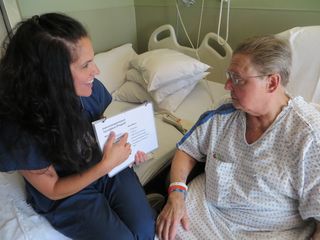Inadequate health literacy is a significant concern in today’s health-care environment. Indeed, more than one-third of Americans don’t understand the basic medical information that’s needed to make informed health-care decisions. This knowledge gap can have serious repercussions: poor medication adherence, increased mortality, and increased hospital readmissions and trips to the ER.
Individuals with inadequate health literacy can be found throughout the United States. The problem doesn’t necessarily have anything to do with a lack of education. Even highly educated individuals can have difficulty understanding health education. “We need to change how staff teach so that patients can learn to care for themselves,” said Carolyn Cutilli, PhD-c, director of Patient and Family Education for the University of Pennsylvania Health System. “It is important for the staff to put themselves in the patient’s shoes and explain concepts in very simple terms.”
At the Hospital of the University of Pennsylvania, improving health literacy has become a major focus over the last few years as health systems work to reduce patient readmissions and improve patient satisfaction and care. Several resources are already available on HUP’s internal website to help staff meet the health literacy needs of patients; courses are offered to increase staff awareness of health literacy and provide tools to improve patient understanding, such as the teachback approach (patients explain instructions in their own words).
“We’re in the midst of a health care transformation, and health literacy is a fundamental part of that process,” said HUP’s Chief Nurse Executive Victoria Rich, PhD, RN, FAAN, who will speak to the issue of health literacy at the upcoming annual Cultural Diversity Conference this month at Penn Presbyterian Medical Center. “As providers, it’s imperative that we acknowledge the unique culture, language and health literacy of diverse populations so that we can help promote better health care for patients across the nation.”
Some clinical areas, though, have taken the challenge to the next level. With a focus on reducing heart failure readmissions, the staff on two patient-care units -- Silverstein 10 and the cardiac intermediate care unit (CICU) -- have developed their own tools to ensure that these patients not only understand what their providers are telling them but remember it as well. '
One tool that all of their patients receive -– the “Cardiac Surgery Journey” welcome sheet -- describes every step of their progress as an inpatient, from arrival at the hospital to surgery to recovery in the CICU and on Silverstein 10, and, ultimately, discharge. “At each step, the sheet describes what needs to be done to continue onto the next,” said Tanya Johnson-Coleman, RN, BSN, MHA, Ed, a nurse on Silverstein 10. In creating the map, “we tried to answer questions that patients always ask, especially what needs to happen before they’re discharged. I think it helps to alleviate the stress and anxiety patients have from not knowing.”
 The staff also created medication cards -– as well as a Penn Heart Vascular Medication Reference Guide -- to help patients better understand their medications, including why they’re taken and potential side effects. The ring of cards is placed by the patient’s bed for easy access, but staff nurses review meds as well, focusing on one medication each day. There is also an in-unit ‘class’ for patients and families which focuses on medications, procedures and problems they might encounter after discharge.
The staff also created medication cards -– as well as a Penn Heart Vascular Medication Reference Guide -- to help patients better understand their medications, including why they’re taken and potential side effects. The ring of cards is placed by the patient’s bed for easy access, but staff nurses review meds as well, focusing on one medication each day. There is also an in-unit ‘class’ for patients and families which focuses on medications, procedures and problems they might encounter after discharge.
The challenge to increase health literacy is also being tackled by Penn’s Center for Innovation. Adam Lang, Innovation manager, and his team explored how improved discharge instructions could better prepare heart failure patients to take care of themselves once they got home from the hospital. The original instructions, he said, “were four to five pages of all text with no prioritization of information. The advice at the end was the same for every patient, regardless of diagnosis.”
In creating a new prototype design, the team “organized and prioritized the information and kept it to one sheet,” said Matt Vandertuyn, Innovation Experience designer. “The information is easier to understand and the design is much more visually appealing.” Although the design is still in the development stage, it has gotten positive feedback from both patients and nurses.
These efforts –- and many others in use throughout the hospital -– will not only keep our patients healthy but also has a financial impact. One section of the HCAHPS survey, which measures patients’ perception of their hospital experience, focuses on communications between doctors and nurses and their patients. The results are tied to a hospital’s payment from the CMS (Centers for Medicare and Medicaid Services). The Joint Commission also has multiple criteria for patient and family education.
Said Lynn Washington RN, Cardiovascular nurse navigator, a leader in HUP's Patient and Family Education Committee, "We have to do a better job at assessing patients’ comprehension of what is important for them to know and what will motivate the behavior changes needed to improve their health and make more informed choices.
"I often tell my patients, ‘If you didn’t understand, it’s because I didn’t do my job.’”